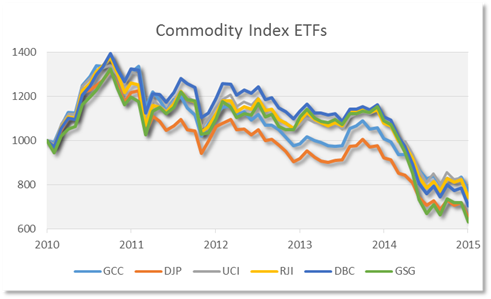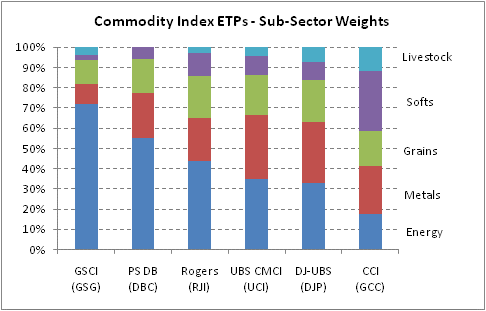If you had a dollar for every article about how horrible commodities have been performing, well.. you’d be rich (or have about as much as if you had shorted said commodity markets). The past few weeks have seen Gold drop below 2010 prices, WTI Crude drop back below $50, and Sugar hit fresh 4 year lows. The result? The long only commodity indices taking it on the proverbial chin…
Here are just a couple headlines and charts associated with the articles:
Are We Nearing Peak Commodity Hatred?
(Disclaimer: Past performance is not necessarily indicative of future results)
Chart Courtesy: Pragmatic CapitalismCommodities: The Great Bear Market
(Disclaimer: Past performance is not necessarily indicative of future results)
Chart Courtesy: The EconomistGlobal Growth Worries Pummel Commodities
(Disclaimer: Past performance is not necessarily indicative of future results)
Chart Courtesy: Wall Street Journal
There are 100s of Commodities Out There:
With headlines like these, you would never know that Canola Oil is at all time highs, Cocoa is at four year highs, or that Natural Gas has barely been moving this year while Crude Oil has been rocking and rolling. Turns out, there’s 100s of different commodity futures markets out there – and more than 30 liquid ones beyond just Gold and Crude Oil. All of these commodities are broken down into five main sectors: Energy, Metals, Grains, Softs, and Livestock., which is about the order in which people think about commodities. We all know Oil is a commodity, and Gold is sort of the commodity poster child, even though it acts a bit more like a currency at times. But you’re deep in the weeds when you start to think of Cocoa or Cattle as commodities.
 Chart Courtesy: Barchart
Chart Courtesy: Barchart
The people who created product around commodities are no dummies, structuring commodity indices around such popularity (at times based on actual metrics like percent of global production value), with a heavy slant towards energy and metals, with the Coffees and Cattles of the world essentially being left behind. The chart above is a little old, from a 2010 BarChart article, but the point remains – there’s more than one way to track “Commodities” via an index. Here’s how the various indices have performed over the past 60 months, highlighting just how different these indices move.

(Disclaimer: Past performance is not necessarily indicative of future results)
It’s not Whether it’s going Up or Down, it’s by How Much
Which brings us back to our little slice of the world in Alternative Investments. You can read how Commodities aren’t all that Alternative in a recession in our ‘Truth & Lies in Alternative Investments’ whitepaper, and the charts above showing the big impact of energy in most commodity indices drives that point. If the S&P 500 has a large portion of companies in energy sector, and energy is a large portion of the commodity indices – does it follow that a large portion of the S&P is tied to commodities? Food for thought.
Thing is – while economists and shipping companies may care how much of a country’s GDP is energy versus Cotton farming; giving value to a value weighted commodity index is something alternative investment managers don’t really care about.
They just want a commodity market – any commodity market – to be moving more than average. We can all grasp how the stock market is more than just the Dow Jones Industrial Average. There are outliers to the upside like Netflix and Apple, outliers to the downside, and everything in between, forming an average; and creating room for ‘stock pickers’ to be able to pick the winners and pan the losers to add value. Professional Alternative Investment managers working in the commodity space take a similar approach, albeit highly systematic and risk controlled as compared to the stigma of a “stock picker.” The commodity pros aren’t just investing in Commodities going up or down – they are looking for the outliers inside of the commodity complex. They are looking for the Netflix of commodities, or Enron on the downside.
So don’t cry for those in commodity futures when the Wall Street Journal waxes on about the big bear market in commodities. We may be crying if it is a slow crawl downwards interspersed with lots of fits and starts, or cheering it down if it’s a significant move in one direction over a few weeks to months.
For an in-depth understanding of how a long/short commodity strategy works, click here.
For a performance comparison of the Commodity Index ETFS vs. managers actively trading the ups and downs of the commodity market, click here.
Copyright © Attain Capital















